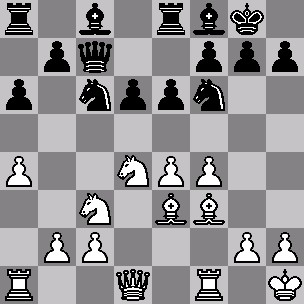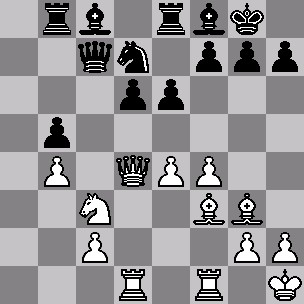15.01.2006
Wijk aan Zee round 2: Adams-Topalov
Adams (2707) - Topalov (2801)
Wijk aan Zee Netherlands (1), 14.01.2006
Annotated by Konstantin Sakaev
1.e4 c5 2.Nf3 d6 3.d4 cxd4 4.Nxd4 Nf6 5.Nc3 a6 6.Be2 e6
Topalov prefers a complex Scheveningen Variation, with the pawn structure defining on the third ten of moves. 6...e5 leads to a typical Najdorf.
7.0-0 Be7 8.a4 Nc6 9.Be3 0-0 10.f4 Qc7 11.Kh1 Re8 12.Bf3 Bf8
This move has been brought into practice relatively recently by Garry Kasparov, and is employed by many advocates of the Sicilian Hedgehog.
13.Qd2 This is still theory. With his last move Adams deviated from his San Luis game against the same opponent. Here is that memorable game: 13.Nb3 b6 14.e5!? dxe5 15.fxe5 Nd7 16.Bxc6 Qxc6 17.Nd4 Qb7 18.Qh5 g6 19.Qh4 Nxe5 20.Ne4 Be7 21.Ng5 Bxg5 22.Bxg5 f5 23.Rae1 Qd5 24.Ne2 Nf7 25.Nf4 Qc6 26.Nh5 Nxg5 27.Nf6+ Kf7 28.Nxe8 Bb7 29.Nd6+ Qxd6 30.Qxg5 Rc8 31.Rf2 Rc4 32.Qh6 Kg8 33.Rd2 Bd5 34.b3 Rc3 35.Qh4 Qc5 36.Rxe6 Bxe6 37.Qf6 Bd5 38.Qd8+ Kg7 39.Rxd5 Qf2 40.Rd7+ Kh6 41.Qf8+ Kg5 42.Qe7+ Kf4 43.Qd6+ Kg5 44.Qe7+ Kf4 45.Qd6+ 0,5-0,5 Adams,M-Topalov,V/San Luis 2005.
13...Na5 The knight strives to c4, but White can defend against it by 14.b3. The drawbacks of this move is that the c3-knight loses some support, and it also deprives another knight of the b3-square.
14.b3 Rb8 15.Rab1 Nc6
A novelty. The game Jansa-Stohl, Germany 2003 continued 15...b6 16.e5! dxe5 17.fxe5 Nd7 18.Bf4 with dengerous initiative by White. Topalov's novelty looks more sensible - having provoked weakening of the queenside, the knight returns to his camp. Still, a thematic break 16.e5!? deserves close examination.
Leko-Karjakin. This position (after 20...Nc7) occurred in the game Almasi-Sakaev, Bundesliga 2004. Black is OK! We agreed to a draw after 21.Qe2 Nxd5 22.Bxd5, but I think Black's position might be even slightly better. If I remember my analysis correctly, White may sacrifice the queen, but it should not alter the evaluation.
16.Bf2 A subtle move in Adams' manner. The bishop might go out to h4, attacking the f6-knight. This idea is especially appropriate if Black carries out e6-e5 break.
16...Nd7 The game develops in a waiting mode. Black last move is a prophilaxis against е5. White may continue the game in the same fashion by, for example, 17.Nce2. Both players are out of book, which is already pleasant. In the aforementioned game Leko-Karjakin we still observe a battle of home preparations. After Leko sacrificed the queen, Karjakin's position is completely in order. If now 24.b3, then 24...Nb5!, exchanging White's strong light-squared bishop. It all had been examined prior to the game with Almasi...
17.Bg3 Predicting Michael Adams' moves is not easy, but I'll keep trying :). Black may complete the development by 17...Nxd4 18.Qxd4 b6, and White, in turn, will undertake a thematic 19.e5.
17...Nxd4 18.Qxd4 b5 And again I failed to guess it right! This time it is Topalov who lets me down. 18...b5 is a crucial decision. Now the e4-e5 breaks are hardly good, but White can make a U-turn and play 19.ab5 ab5 20.b4, fixing the wekness on b5, which can be attacked by Bf3-e2.
Ivan Sokolov has an advantage against Ivanchuk, he can now play 15.Qb3 Nc6 16.0-0. White is better. Anand presses on Aronian, the World Cup winner's position looks suspicious, although White's last move (25.Re3) seems dubious to me, more logical was 25.Bg5 Rdb8 26.Nf6+ Kh8 27.Nd5 followed by f2-f4. Bacrot has a very insignificant plus against Tiviakov - this might end peacefully. And Mamedyarov is hardly at risk against van Wely.
Kamsky has an advantage: Gelfand's compensation for a sacrificed exchange is insufficient. White can play 22.Rb1! Qe5 23.Rc1 Nd2 24.Rc2 Nb3 25.Qa3, and White unpins, retaining the extra material.
19.axb5 axb5 20.b4
20...g6 A significant weakening of the light squares. Now after 21.Be2 Bg7 22.e5 Qc6 23.Rf3 d5 or an immediate 21.e5 d5 a favorable for White structure arises.
21.e5 d5 22.f5! Adams proves that he also can play energetically when it is demanded. Now a heavy blow on d5 threatens in differemnt versions. 22...gxf5 23.Nxd5 Qc4 (the knight is immune due to 24.е6) 24.Nf6+ (White has a rich choice - the queen may retreat to f2, preserving a strong attack, and the endgame after 24.Qxc4 bxc4 25.Nc7 Re7 26.c3 does not promise easy life for Black) Nxf6 25.exf6 Qxd4 26.Rxd4 e5 27.Re1 Bb7 28.Bxe5 Bxf3 29.gxf3 Rbc8 30.Re2 with good winning chances in the endgame.
22...gxf5
23.Nxd5 Qc4 24.Qd2 This is also possible! The queen goes to g5. Taking the knight loses to 25.Qg5+ and 26.Bxd5 with terrible attack. Black's best chance is 24...h6! The White's queen must not appear on g5! Thus 25.Nf6+ Nxf6 26.exf6 e5 with some chances to survive. Another possibility that does not lose on the spot is 24...Kh8 25.Qg5 Bb7, but after 26.Ne3 Black's position is still bad.
24...h6 25.h3!?
Adams continues a highly dangerous attack! Playing in his style... The text provides some air for the king and deprives the Black's queen the g4-square after ...exd5 Bxd5. Now Black has problems with useful moves, as taking the knight seems impossible: 25...exd5 26.Bxd5 Qxb4 27.c3, and White develops his attack at high pace.
Michael impresses! Not many players could have found such a move as 25.h3!
25...exd5 26.Bxd5 Qxb4. Adams has just 19 minutes left, but I think that Topalov will hardly survive White's attack after 27.c3 followed by Rxf5, etc.
Gelfand made a fortress against Kamsky, but blundered in a completely drawn position... Gata returns to 50 per cent.
27.c3 Qc5 28.Rxf5.
Topalov's position is hopeless. Mickey even does not have to play perfectly, he just needs to capture something on every move. On 28...Re6 follows 29.Rxf7 Kxf7 30.Qf4+. Relatively best for Black is 28...Ne5, for which the Englishman may play 29.Rxe5 Rxe5 30.Be5 Rb6 31.Bd4, transposing into a technically won position.
28...Re6 29.Rxf7 Nb6 White wins by 30.Qf4, and on 30...Nxd5 31.Rxd5!, another possibility is 30.Rdf1 Nxd5 31.Rxf8+ Qxf8 32.Rxf8+ Kxf8 33.Qxd5, and with opposite-colored bishops White must win quickly.
30.Rdf1 Now on 30...Bg7 Adams mates by 31.Qf4 with decisive threats 32.Rg7 and 32.Qg4.
30...Nxd5 31.Rxf8+ Qxf8 32.Rxf8+ Kxf8 33.Qxd5 Ke8 Could well resign instead.
34.Bh4 Bd7 35.Bf6 b4 36.Qe4 Bc8 37.cxb4 Rb7 38.Qg6+ Kd7 39.Qxh6 Kc7 40.Qf4 Kb8 41.h4 Rc7 42.h5 Black resigned. 1-0
The best game of the festival so far. A brilliant 25.h3!! could be called the move of the tournament. Topalov suffered his first defeat since becoming the world champion. Now playing will become easier for him.
In Bacrot-Tiviakov I would mention a nice move 35.Rd5!, which was probably overlooked by Tiviakov. Etienne nursed a slightly better position to a win - well done!
Aronian got an inferior position after the opening, and was forced to play for a draw for the whole game. After 48.g4 Anand's chances to win are equal to Aronian's chances to make a draw.
Vasily Ivanchuk conducted his today's game superbly. His win is the most likely outcome, although Sokolov keeps some nebulous hopes for a draw.
Leko in his style offered a draw in a complex position. Although an objective evaluation is probably indeed "balanced", but the situation was double-edged.
In the third round we will broadcast the game of the leaders: Ivanchuk-Anand. See you tomorrow!
Back to the main page







